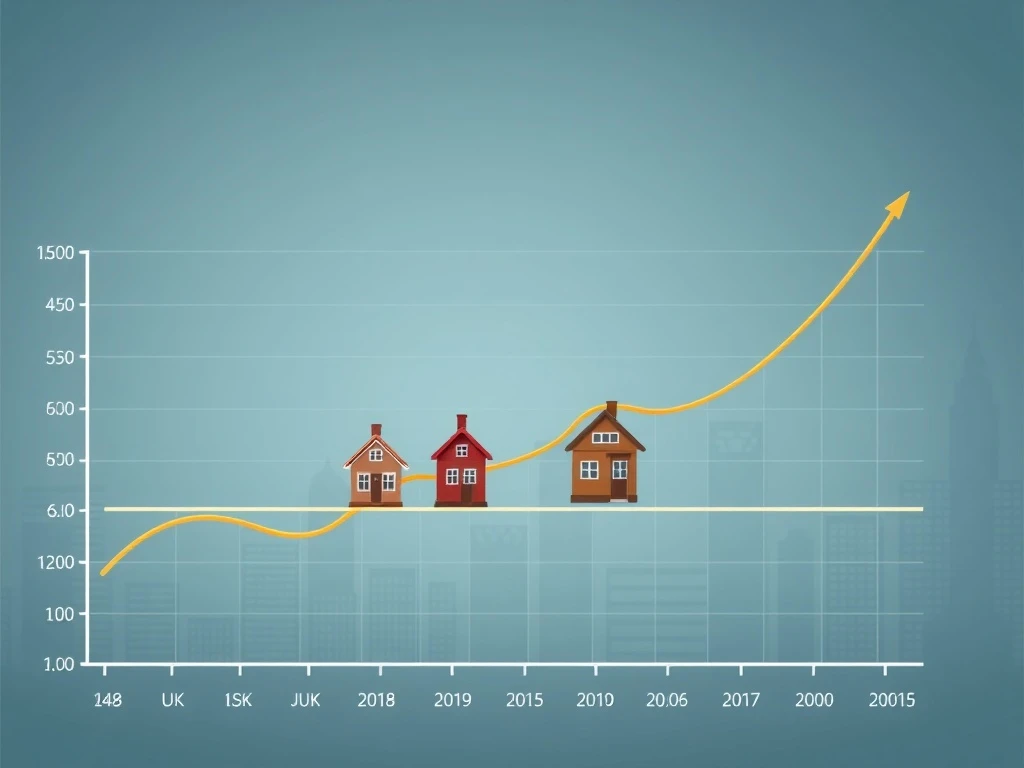The UK housing market has demonstrated remarkable strength. Specifically, UK house prices recorded their fastest monthly growth of 2025 in July. This significant increase highlights the market’s surprising resilience. It persists despite ongoing cost-of-living pressures and recent tax changes. For many, this signals a more stable outlook than previously anticipated.
UK House Prices See Remarkable Monthly Surge
In July, UK house prices rose by 0.4%. This figure comes from the latest data released by Halifax. The increase surpassed economists’ predictions, who had forecast a 0.3% rise. This positive movement underscores the market’s robust nature. Annually, prices were 2.4% higher compared to July 2024. The average price reached £298,237. While slightly slower than June’s 2.7% annual growth, these figures align with rival lender Nationwide’s report. Nationwide noted a 0.6% monthly rise for July. Therefore, the market appears to have found a stable footing.
This stability follows a period of heightened activity earlier in the year. Many buyers accelerated their transactions. They aimed to avoid changes to stamp duty thresholds. These adjustments came into effect in April. Consequently, the market saw a temporary surge. Now, it seems to have normalized. This indicates a sustained demand for housing across the nation. Moreover, buyers continue to adapt to the evolving financial landscape.
The Impact of Stamp Duty Changes on UK House Prices
Labour’s October 2024 budget introduced significant stamp duty adjustments. These changes lowered the tax application point. For most buyers, it dropped from £250,000 to £125,000. First-time buyers also saw a reduction, from £425,000 to £300,000. These reforms prompted a rush of property transactions. Many consumers completed purchases before the April deadline. This initial flurry contributed to earlier market fluctuations. However, the market has since absorbed these changes. It continues to demonstrate underlying strength. The long-term effects on UK house prices remain a key area of observation.
Property experts closely monitor the market’s response to these tax reforms. While some anticipated a slowdown, the current data suggests otherwise. Buyers are clearly prioritizing homeownership. This sustained demand helps underpin property values. Furthermore, the market’s ability to absorb such policy shifts indicates its fundamental health. This adaptability is crucial for future stability.
Mortgage Market Dynamics and Improving Affordability
Amanda Bryden, Head of Mortgages at Halifax, anticipates modest gains for UK house prices throughout the rest of the year. She acknowledges ongoing challenges for those entering or moving up the property ladder. Nevertheless, several positive factors support the market. Mortgage rates continue to ease. Wages are still rising steadily. Moreover, affordability is gradually improving for many households. These combined elements create a more favorable environment for buyers. Bryden concludes that the housing market “continues to show resilience, with activity levels holding up well.”
Official figures further support this picture of market momentum. Data from HM Revenue and Customs (HMRC) shows a robust increase in residential property sales. Seasonally adjusted transactions rose by 13.4% in June. This totaled 93,530 sales. Similarly, the Bank of England (BoE) reported a 1.4% increase in mortgage approvals for house purchases during June. Approvals reached 64,167. These statistics collectively paint a picture of a dynamic and active housing sector. They indicate a healthy level of buyer confidence and lending activity.
Navigating Mortgage Refinancing in the Current Climate
The latter half of 2025 will see a notable number of homeowners reaching the end of their fixed-rate mortgage deals. Many of these agreements originated during the pandemic-era housing boom. Those on two-year fixes, agreed after the 2022 mini-budget, will likely see their monthly payments decrease. This provides some relief. However, homeowners on five-year fixed rates may face increases. The scale of these rises will vary significantly between households. This period of refinancing presents both opportunities and challenges. It requires careful financial planning for many.
Homeowners should review their mortgage options proactively. Speaking with a financial advisor can provide clarity. This helps them understand potential payment changes. The evolving interest rate landscape directly impacts these decisions. Therefore, staying informed about market trends is vital. This ensures homeowners can make the best choices for their financial well-being. Ultimately, adaptability remains key in this dynamic environment.
Bank of England’s Rate Cut and Future Outlook for UK House Prices
This week, the Bank of England made a significant decision. It cut its base rate to 4% from 4.25%. This marks the fifth reduction within a year. This move is expected to further improve mortgage affordability. Lower borrowing costs generally stimulate demand. However, the scope for additional cuts remains uncertain. Persistent inflationary pressures continue to pose a challenge. Furthermore, signs of a cooling jobs market add to this complexity. The Bank balances stimulating growth with controlling inflation. This delicate act influences future rate decisions. Therefore, the trajectory of UK house prices hinges on these policy choices.
Economic indicators provide a mixed picture. While inflation has eased from its peaks, it remains above the Bank’s target. The labor market, once exceptionally tight, shows signs of softening. This balance of factors makes predicting future interest rate movements difficult. Homebuyers and sellers closely watch these developments. Each rate cut potentially lowers mortgage costs. Conversely, persistent inflation could limit further reductions. The Bank’s cautious approach reflects these ongoing uncertainties.
Regional Disparities in UK House Price Growth
Price growth continues to vary significantly across the UK. Northern Ireland recorded the strongest annual increase. Prices there rose by 9.3%, reaching an average of £213,832. Scotland also saw strong growth, with values up 4.7% to £125,238. Welsh property prices increased by 2.7%, averaging £227,928. These regional differences reflect diverse local economic conditions. They also show varying supply and demand dynamics.
In England, the North West and Yorkshire & Humber both experienced robust growth. Each region recorded a 4% increase. Average prices reached £242,293 in the North West and £215,532 in Yorkshire & Humber. Conversely, gains in the south of England were far more modest. They saw less than 1% year-on-year growth. London remains the most expensive region. The average home now costs £539,914. These disparities highlight the localized nature of the UK housing market. Factors like job opportunities, transport links, and housing stock availability influence these trends.
Factors Shaping the Future of UK House Prices
The housing market has outperformed many forecasts so far in 2025. Its future trajectory, however, depends on a complex interplay of factors. Interest rate policy remains crucial. Wage growth also plays a significant role. Furthermore, the broader economic climate directly impacts consumer confidence and purchasing power. For now, resilient demand is a key driver. Easing mortgage rates further support this. Steady transaction volumes also contribute to market stability. Despite these positive signs, affordability challenges persist for many. This remains a critical hurdle, particularly for first-time buyers.
Government initiatives and supply-side factors will also influence future trends. Policies aimed at increasing housing stock could ease price pressures. Conversely, a tightening of lending criteria might slow growth. The overall health of the UK economy will ultimately dictate the market’s long-term performance. While current data points to resilience, vigilance remains essential. Stakeholders must monitor these evolving dynamics. This ensures informed decisions for all participants in the housing sector.
The UK housing market demonstrates a surprising degree of resilience. It navigates economic headwinds and policy changes effectively. The fastest monthly rise in UK house prices in July 2025 signals robust underlying demand. It also reflects improving affordability conditions. While regional variations and affordability hurdles remain, the market’s momentum appears set to continue. This offers a cautiously optimistic outlook for homeowners and prospective buyers alike.
Frequently Asked Questions (FAQs)
What caused the fastest monthly rise in UK house prices in July 2025?
The fastest monthly rise in UK house prices was primarily driven by continued resilient demand and easing mortgage rates. Halifax reported a 0.4% increase, exceeding economists’ expectations, indicating strong underlying market momentum.
How have recent stamp duty changes impacted the UK housing market?
Recent stamp duty changes, effective April 2025, initially prompted a rush of transactions as buyers aimed to beat the new thresholds. While this created some early market volatility, the market has since stabilized, demonstrating its ability to absorb policy shifts.
What is the outlook for mortgage rates in the UK?
Mortgage rates continue to ease, partly due to the Bank of England’s recent decision to cut its base rate to 4%. This trend is expected to improve affordability further. However, future cuts remain uncertain due to persistent inflationary pressures and a cooling jobs market.
Which regions of the UK are seeing the strongest house price growth?
Northern Ireland recorded the strongest annual increase at 9.3%. Other strong performing regions include Scotland (4.7%), Wales (2.7%), and in England, the North West and Yorkshire & Humber (both 4%). London remains the most expensive, despite more muted growth in the South.
Are UK house prices expected to continue rising throughout 2025?
Halifax anticipates a steady path of modest gains for UK house prices through the remainder of 2025. This outlook is supported by easing mortgage rates, rising wages, and improving affordability, despite ongoing challenges.
























